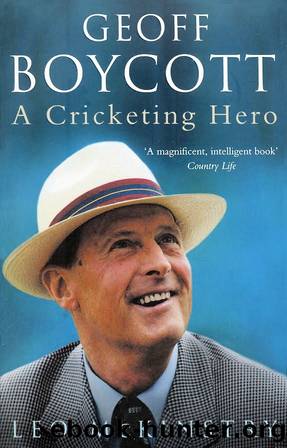Geoff Boycott: A Cricketing Hero by Leo McKinstry

Author:Leo McKinstry [McKinstry, Leo]
Language: eng
Format: epub
Tags: Biography, Autobiography, Sports, Sports & Recreation, Cricket, Non-Fiction
ISBN: 9780007375448
Google: VisBY4yY4HgC
Amazon: 0007196938
Publisher: Willow
Published: 2005-05-02T23:00:00+00:00
18
Return of the Master
Because his talent for attracting controversy matched his gift for making runs, Geoffrey Boycott has never really received the credit he deserved for his magnificent, 18-year Test career. Whatever the complaints about his behaviour at Yorkshire, there can be little dispute that his Test performances put him among the all-time greats. Peter May is often referred to as the finest English batsman produced since the war, yet Boycott averaged more per innings over a much longer career against tougher bowling attacks around the world. Similarly, of the six Englishmen who have scored more than 7500 Test runs, Atherton, Boycott, Cowdrey, Gooch, Gower and Stewart, Boycott at 47.72 has the highest batting average. At the twin peaks of his Test career, in 1970/71 and 1977, Boycott was probably the best opening batsman in the world. The supreme Indian Sunil Gavaskar could justifiably lay claim to that title at other times in the seventies and early eighties, but Boycott still enjoys a better Test record than all of his other great contemporary openers, Bobby Simpson, Bill Lawry, Glenn Turner, Keith Stackpole, Roy Fredericks, Desmond Haynes, Conrad Hunte, Gordon Greenidge and Mudassar Nazar. It is probably no coincidence that, following his retirement in 1982, England’s batting was mired in a state of near permanent crisis until the recent heart-warming revival under the leadership of Nasser Hussain and then Michael Vaughan.
When Boycott returned from Australia in the spring of 1979, his future as a Test player looked bleak. Few who watched his leaden-footed batting in Australia would have believed that here was a man who, over the next two years, would emerge triumphant against the world’s most formidable bowlers. But that is exactly what Boycott was soon to achieve against full-strength Australian and West Indian attacks, destroying for ever the myth that he was reluctant to face quick bowling.
After his drastic loss of form on tour, Boycott took the only step he could to iron out the problems in his technique: repeated net practice. At the MCC indoor school at Lord’s, he worked for session after session on returning to a more classical, side-on stance, playing with the full face of the bat rather than closing it. The fluency began to return and by the start of the 1979 season, Boycott was refreshed and eager for battle. He felt he had a point to prove for both Yorkshire and England after the disasters of the previous 12 months, and he did so in the most emphatic style. During the summer, he became the first cricketer in the history of the game to average over 100 for the second time in a domestic season, hitting 1538 runs at 102.53. At one stage for Yorkshire, he scored centuries in three successive matches, his third hundred being 175 made in just four and three-quarter hours against Nottinghamshire, carrying his bat through the Yorkshire innings of 360. Against Somerset at Harrogate, he and Richard Lumb put on 288 for the first wicket, the highest opening
Download
This site does not store any files on its server. We only index and link to content provided by other sites. Please contact the content providers to delete copyright contents if any and email us, we'll remove relevant links or contents immediately.
| Cricket | Field Hockey |
| Lacrosse | Rugby |
| Track & Field | Volleyball |
Going Long by Editors of Runner's World(1920)
The Happy Runner by David Roche(1818)
Yoga For Dummies by Georg Feuerstein(1204)
Legacy by Kerr James(1054)
Becoming Boston Strong by Amy Noelle Roe(1022)
Winger by Smith Andrew(996)
The Little Red Book of Running by Scott Douglas(884)
Bowerman and the Men of Oregon by Kenny Moore(882)
Wodehouse At the Wicket by P.G. Wodehouse(864)
5050 by Dean Karnazes(838)
The Way of the Runner by Adharanand Finn(834)
Running Your First Marathon by Andrew Kastor(829)
Swim, Bike, Run - Eat by Tom Holland(828)
The Coming Storm by Nigel McCrery(777)
Spiked (Blocked Book 3) by Jennifer Lane(771)
Blade Runner by Oscar Pistorius(752)
The Shared Origins of Football, Rugby, and Soccer by Christopher Rowley(748)
The Amazing Test Match Crime by Adrian Alington(747)
The Grade Cricketer by Dave Edwards(745)
